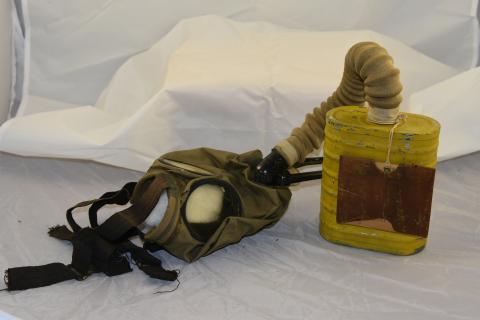This is an American RFK-type gas mask used and produced for the American Expeditionary Force (AEF) during the First World War. It features a single sheet of rubberized material that forms the bulk of the facial shielding, with two large glass lenses framed with metal rims. The rubberized mask terminates towards the bottom with a metal tube connected by screws to the rubberized portion. This metal tube fixture serves as an anchor for the rubberized ridged breathing tube that leads to the mask's box respirator. The tube is less than 1 foot long and covered in a treated cloth material. The respirator box is rectangular with rounded sides and painted yellow. The bottom of the respirator box features the opening for the mask's filter. The purpose of this box respirator is to filter out particulate matter in the air to protect wearers against chemical gas attacks. Attached to the box respirator is the mask's instruction manual in a sealed paper envelope. The RFK-type American mask was a descendent of the British Short-Box Respirator, which was developed towards the beginning of the war. As the war progressed, the American Army began mass producing their own modifications of this prototype, resulting in a product of roughly 3 million RFK-type masks by the time the Armistice was declared in 1918. Effective against many common chemical weapons, the RFK gas mask is a staple of WWI, despite its rather short service time during the war. This content can be used with the following resources: SS.4.25: Technological Change SS-WH.9-12.26: Iowans Influence World History This content can be used to educate students on the advancements that were made to military protective equipment during the First World War and how those advancements affected the lives of Iowan servicemen. It can also be used to educate students on the impacts that Iowans had during the course of the war. For any use other than instructional resources, please check with the organization that owns this item for any copyright restrictions.
2018.002.025 [Mask, Gas]
Legal Status
Copyright to this resource is held by the Iowa Masonic Library and Museum and has been provided here for educational purposes only, specifically for use in the Iowa Museum Association's "Teaching Iowa History" project. It may not be downloaded, reproduced or distributed in any format without written permission from the Rights Holder. For more information on U.S. and International copyright laws, consult an attorney.

